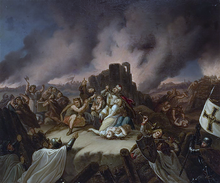Pilėnai
| Siege of Pilėnai | |||||||
|---|---|---|---|---|---|---|---|
| Part of the Lithuanian Crusade | |||||||
 Duke Margiris defending Pilėnai against the Teutonic Order by Władysław Majeranowski (1817–1874) |
|||||||
|
|||||||
| Belligerents | |||||||
| Teutonic Order | Grand Duchy of Lithuania | ||||||
| Commanders and leaders | |||||||
| Dietrich von Altenburg | Margiris † | ||||||
| Strength | |||||||
| 200 nobles; 6,000 total soldiers | 4,000 people | ||||||
| Casualties and losses | |||||||
| Minimal | Nearly all | ||||||
Pilėnai (also Pillenen in German) was a hill fort in the Grand Duchy of Lithuania. Its location is unknown and is subject to academic debates, but it is well known in the history of Lithuania due to its heroic defense against the Teutonic Order in 1336. Attacked by a large Teutonic force, the fortress, commanded by Duke Margiris, tried in vain to organize a defense against the larger and stronger invader. Losing hope, the defenders decided to burn their property and commit mass suicide to deprive the Order from prisoners and loot (cf. scorched earth). This dramatic episode from the Lithuanian Crusade has caught the public imagination, inspired many works of fiction, and became a symbol of Lithuanian struggles and resistance.
The attack and the defense of Pilėnai were briefly mentioned in several contemporary chronicles, including Epitome gestorum Prussiae by a Sambian canon, Der Chronist von Wolfenbüttel (Chronicler of Wolfenbüttel), Annalista Thorunensis (Annals of Thorn), and Kurze Reimchronik von Preussen (Short Rhymed Chronicle of Prussia). However, these sources recite the basic facts and do not provide enough information to reconstruct the events.
The only contemporary source that describes the events in greater detail is the chronicle of Wigand of Marburg. However, Wigand's original German text has not survived. His work is known from a Latin translation commissioned by Jan Długosz in 1464. Several excerpts of the original German text were published by Caspar Schütz (died 1594) and Stanislaus Bornbach (died 1597). When Theodor Hirsch prepared Wigand's chronicle for publication in Scriptores Rerum Prussicarum, he included these excerpts alongside the Latin translation. In particular, Hirsch believed that Schütz's text on Pilėnai was more complete and accurate copy of Wigand than the Latin translation. This opinion has been widely accepted and historians used Schütz's text, which paints a much more heroic and dramatic picture of Pilėnai, as Wigand's original. This long-standing belief has been challenged by Lithuanian historian Darius Baronas. He has shown that Schütz's text was an unreliable and embellished retelling of Wigand's work. Therefore, the only reliable source is the Latin translation of Wigand's chronicle.
...
Wikipedia
